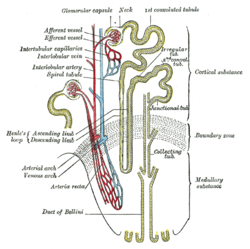Descending limb of loop of Henle
| Descending limb of loop of Henle | |
|---|---|
 Scheme of renal tubule and its vascular supply. (Labeled at center left.) | |
 Nephron ion flow diagram | |
| Details | |
| Identifiers | |
| Latin | pars descendens ansae nephricae |
| FMA | 17719 17705, 17719 |
| Anatomical terminology | |
Within the nephron of the kidney, the descending limb of loop of Henle is the portion of the renal tubule constituting the first part of the loop of Henle.
Physiology
The permeability is as follows:
| Substance | Permeability |
| ions | Low permeability. Sodium and chloride ions do not easily pass through.[1] |
| urea | Moderate permeability.[2] |
| water | Highly permeable. Water is readily reabsorbed from the descending limb by osmosis.[3] |
Also, the medullary interstitium is highly concentrated (because of the activity of the ascending limb), leading to a strong osmotic gradient from the descending limb to the medulla.
Because of these factors, the concentration of the urine increases dramatically in the descending limb. Osmolality can reach up to 1400 mOsmol/kg by the end of the descending limb.[3]
Histology
The epithelium of the Thick segment is low simple cuboidal epithelium. The epithelium of the Thin segment is simple squamous.[4]
They can be distinguished from the vasa recta by the absence of blood, and they can be distinguished from the thick ascending limb by the thickness of the epithelium.[5]
Nomenclature
Like the ascending limb, the descending limb has thick and thin portions. However, this distinction is not as important physiologically as in the ascending limb, so often the two are treated as one structure. The thick descending limb is less important than the thin descending limb, so often the terms "descending limb" and "thin descending limb" are used interchangeably.
Some sources simply refer to a "thin limb". In this context, the thin ascending limb of loop of Henle would be included.
Additional images
-
Longitudinal section of descending limb of Henle’s loop. a. Membrana propria. b. Epithelium.
References
![]() This article incorporates text in the public domain from page 1223 of the 20th edition of Gray's Anatomy (1918)
This article incorporates text in the public domain from page 1223 of the 20th edition of Gray's Anatomy (1918)
- ^ "a.The descending limb of the loop of Henle is highly permeable to water and relatively impermeable to solutes such as Na and Cl". Archived from the original on 2006-05-19. Retrieved 2006-11-25.
- ^ Nosek, Thomas M. "Section 7/7ch08/7ch08p09". Essentials of Human Physiology. Archived from the original on 2016-03-24.
- ^ a b Nosek, Thomas M. "Section 7/7ch07/7ch07p09". Essentials of Human Physiology. Archived from the original on 2016-03-24.
- ^ "University of Illinois College of Medicine". Archived from the original on 2010-07-08. Retrieved 2009-12-04.
- ^ Histology image:15804loa from Vaughan, Deborah (2002). A Learning System in Histology: CD-ROM and Guide. Oxford University Press. ISBN 978-0195151732.